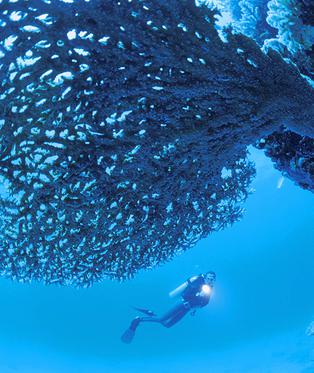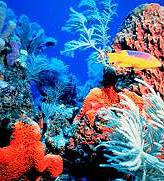“How inappropriate to call this planet Earth when it is quite clearly Ocean.” -Arthur C. Clarke
Our planet is unique, thanks to the presence of water and ocean! Protecting the ocean and its inhabitants is one of the biggest challenges we face. One reason is that scientistis have only scratched the surface of understanding all the dynamics and secrets of our underwater world. Yet we do know enough to observe and measure how the ocean environment is changing, the ways that we contribute to these changes and and what the implications are for our future if we don’t act.
Warm Water Woes
 As climate change has warmed the Earth, oceans have responded more slowly than land environments. Global warming has raised the average global temperature by about 0.6°C (1°F) over the past century. In the oceans, the change has been an increase of about 0.1°C (0.18°F) from the surface to deeper areas where most marine life thrives. While the change may be less in terms of degrees, the impact on sea life and the ocean environment may be greater.
As climate change has warmed the Earth, oceans have responded more slowly than land environments. Global warming has raised the average global temperature by about 0.6°C (1°F) over the past century. In the oceans, the change has been an increase of about 0.1°C (0.18°F) from the surface to deeper areas where most marine life thrives. While the change may be less in terms of degrees, the impact on sea life and the ocean environment may be greater.
Scientific research is finding that the ocean’s ecosystems can be much more sensitive to even slight average temperature increases. Corals are particularly vulnerable. Coral bleaching occurs (where reefs eject their symbiotic algae) at a slight persistent temperature rise. Bleaching slows coral growth, makes them susceptible to disease, and when combined with ocean acidification, is a severe threat to our reefs. Corals can be likened to the architecture of the ecosystem. When the structure goes, there goes the whole ecosystem.
Some organisms may actually benefit from the warmer temps, but the effects of that can be negative. Researchers found that increasing temperatures, although initially enhancing the growth of phytoplankton, allowed increased grazing by zooplankton (microscopic animals) and bacteria.
Warmer sea temperatures are also connected with the spread of invasive species and marine diseases, which can lead to forced migrations and even species extinctions.
When water heats up, it expands. That, plus the melting of the ice shelfs, results in a rapid rise in sea level. Sea level rise causes inundation of coastal habitats for humans as well as plants and animals, shoreline erosion, and more powerful storm surges that can devastate low-lying areas.
Matters of Life and Death
 Ocean life is incredibly diverse. Scientists have identified about 230,000 species of marine plants and animals plus a few thousand bacteria and other microorganisms. The balance of life and biodiversity in the ocean play a crucial role in our planet’s environment. Since species are interdependent, the disappearance of one can lead to the decrease or demise of others, which can weaken and endanger entire ecosystems.
Ocean life is incredibly diverse. Scientists have identified about 230,000 species of marine plants and animals plus a few thousand bacteria and other microorganisms. The balance of life and biodiversity in the ocean play a crucial role in our planet’s environment. Since species are interdependent, the disappearance of one can lead to the decrease or demise of others, which can weaken and endanger entire ecosystems.
Another key stressor to the ocean environment is what is known as “dead zones.” Researchers analyzing these zones in the ocean say they have been increasing. More than 400 areas of these zones exist in coastal areas, where the seafloor has too little oxygen to support most marine life. Dead zones affect an area of 95,000 square miles, about the size of New Zealand. While the zones can occur naturally, they primarily developed near areas where heavy agricultural and industrial activity spill chemical nutrients into the water, particularly nitrogen and phosphorous.
One other area of concern is sound “pollution” from seismic testing for oil drilling and shipping activities, which can disrupt marine mammals such as whales that use low frequency sounds to communicate. Changes in seawater chemistry through acidification can also contribute to making it noisier in the ocean through decreased sound absorption in the more acidic water causing sound to travel further distances.
Of course, it’s not just animal and microbial life that is important. Plant life in coastal areas is also critical. Besides their use for habitats, mangroves, salt marshes and seagrass meadows absorb more carbon from the atmosphere than the equivalent amount of plants in rainforests.
Humankind’s impacts on marine biodiversity, coastal area health and the ocean’s acoustics must be curtailed to protect and conserve these ecosystems.
One important strategy for conservation is the establishment of marine sanctuaries called marine protected areas where human activites are limited. There are nearly 6,000 MPAs established, encompassing over 1% of the world’s oceans. These underwater parks protect critical habitats and have shown to help improve biodiversity and ocean health.
Resources:
New Comparison of Ocean Temperatures Reveals Rise over the Last Century
What is Coral Bleaching
Ocean Dead Zones
Dead Zone Formation
Map of large marine protected areas


